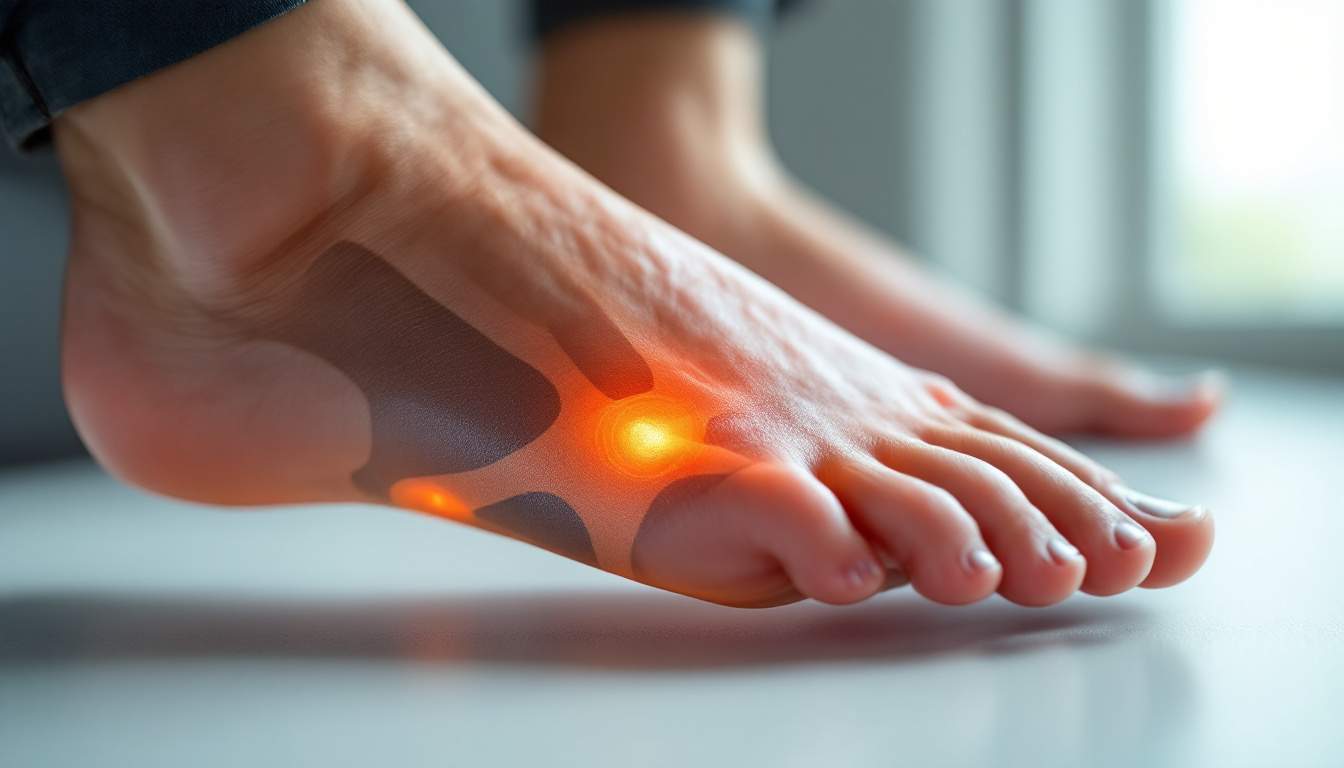
Comprehensive Guide to Understanding Myxoid Cysts: Causes, Symptoms, and Treatment Options
November 4, 2024
Pain Management Dr. Near Me: A Comprehensive Guide
January 23, 2025Anatomy of the Subtalar Joint: A Detailed Examination
The subtalar joint, located between the talus and calcaneus bones, plays a crucial role in foot movement. This joint allows for inversion and eversion of the foot, which is essential for maintaining balance and adapting to various surfaces while walking or running.
Structurally, the subtalar joint consists of two primary articular surfaces: the anterior and posterior facets. These surfaces are covered with cartilage, facilitating smooth movement. The joint is encased in a synovial membrane, which produces fluid to nourish the cartilage and reduce friction during motion.
In addition to its structural components, the subtalar joint is supported by an intricate network of ligaments that provide stability and limit excessive motion. The interosseous talocalcaneal ligament, for instance, plays a pivotal role in maintaining the alignment of the talus and calcaneus, while the lateral and medial ligaments help to control the range of motion during activities such as running, jumping, and lateral movements. This complex interplay of ligaments ensures that the subtalar joint can efficiently absorb shock and distribute forces across the foot, which is particularly important during high-impact activities.
Moreover, the subtalar joint’s function extends beyond mere mobility; it is integral to the kinetic chain of the lower extremity. The subtalar joint works in concert with the ankle joint and the midfoot to facilitate proper gait mechanics. When the subtalar joint is functioning optimally, it allows for effective shock absorption and propulsion, which are vital for athletic performance. Conversely, dysfunction or injury to this joint can lead to compensatory movement patterns, resulting in pain and potential injury in other areas of the body, such as the knees, hips, and lower back. Understanding the subtalar joint’s anatomy and function is therefore essential for both injury prevention and rehabilitation in athletes and active individuals alike.
The Role of the Subtalar Joint in Foot Mechanics
Understanding the subtalar joint’s role in foot mechanics is vital for appreciating its functionality. It acts as a pivot point, allowing for mobile adaptation and shock absorption. This adaptability is crucial when navigating uneven terrains, reducing the risk of injuries. The subtalar joint, located between the talus and the calcaneus, is unique in its ability to allow for inversion and eversion of the foot, which is essential for maintaining balance and stability during various activities, from walking on a flat surface to hiking on rocky trails.
When the subtalar joint functions optimally, it contributes to proper alignment in the kinetic chain, affecting not only foot and ankle biomechanics but also the knees and hips. A well-functioning subtalar joint can perform the following:
- Support shock absorption
- Facilitate smooth gait patterns
- Optimize propulsion during movement
Furthermore, the subtalar joint plays a critical role in the body’s overall posture and alignment. Its ability to adapt to the ground surface allows for efficient weight distribution across the foot, which is particularly important during high-impact activities such as running or jumping. When the subtalar joint is compromised, it can lead to compensatory mechanisms in other joints, potentially resulting in overuse injuries or chronic pain. This highlights the importance of maintaining flexibility and strength in the muscles surrounding the subtalar joint, as well as the need for appropriate footwear that supports its natural movements.
In addition to its mechanical functions, the subtalar joint is also influenced by proprioceptive feedback from the surrounding tissues. This sensory information helps the body make quick adjustments to maintain balance and stability, especially during dynamic activities. Training that focuses on enhancing proprioception, such as balance exercises or agility drills, can significantly improve the subtalar joint’s performance and, by extension, the overall functionality of the lower extremities. Understanding these intricate relationships is essential for athletes, coaches, and rehabilitation professionals aiming to optimize performance and prevent injuries.
Common Disorders Affecting the Subtalar Joint
Several disorders can compromise the health and functionality of the subtalar joint. Common issues include:
- Subtalar arthritis
- Talocalcaneal coalition
- Chronic ankle instability
- Subtalar joint impingement
Statistics show that subtalar arthritis affects approximately 5% of individuals over the age of 50. Meanwhile, a talocalcaneal coalition is found in 1% of the population, highlighting the need for awareness and proactive management.
Subtalar arthritis, characterized by the degeneration of cartilage in the joint, can lead to significant pain and stiffness, severely impacting mobility. Patients often report difficulty with activities that involve walking on uneven surfaces or prolonged standing, which can exacerbate their symptoms. Treatment options range from conservative approaches, such as physical therapy and anti-inflammatory medications, to more invasive procedures like joint injections or even surgical intervention in severe cases.
On the other hand, talocalcaneal coalition, a condition where the talus and calcaneus bones are abnormally fused, can manifest in childhood and may not be diagnosed until later in life. This disorder can lead to flatfoot deformities and chronic pain, particularly during physical activities. Early detection through imaging techniques, such as X-rays or MRI, is crucial for effective management, which may include orthotic devices or surgical correction to restore normal foot function and alleviate discomfort.
Symptoms and Diagnosis of Subtalar Joint Dysfunction
Identifying symptoms of subtalar joint dysfunction is crucial for timely intervention. Common symptoms include:
- Pain localized around the arch or heel
- Swelling around the joint
- Stiffness during movement
- Limited range of motion
Diagnosing these disorders typically involves a thorough physical examination, imaging tests like X-rays or MRIs, and evaluating the patient’s history. Clinicians may also use functional assessments to gauge the full extent of the issue.
In addition to the aforementioned symptoms, patients may experience discomfort during activities that involve weight-bearing, such as walking or running. This can lead to compensatory gait patterns, which may further exacerbate the problem by placing additional stress on other joints in the lower extremity. Patients might also report a feeling of instability in the ankle, particularly when navigating uneven surfaces, which can heighten the risk of falls and injuries.
To enhance the diagnostic process, healthcare providers often consider the patient’s lifestyle and activity level. For instance, athletes or individuals engaged in high-impact sports may present with different symptoms compared to those with a sedentary lifestyle. This comprehensive approach allows clinicians to tailor a treatment plan that not only addresses the immediate symptoms but also considers the underlying causes and the patient’s long-term functional goals.
Non-Surgical Treatment Options for Subtalar Joint Disorders
For many individuals, non-surgical treatment options can effectively manage subtalar joint disorders. Common approaches include:

- Physical therapy: Exercises designed to improve range of motion and strengthen supporting muscles.
- Orthotics: Custom shoe inserts can help alleviate stress on the joint.
- Medications: Nonsteroidal anti-inflammatory drugs (NSAIDs) can help reduce pain and swelling.
- Activity modification: Tailoring physical activity to avoid exacerbating symptoms.
Studies suggest that conservative measures can yield improvement in over 80% of cases, allowing patients to return to daily activities without resorting to surgery.
Surgical Interventions: When Is Surgery Necessary?
While many conditions can be treated non-operatively, surgery may become necessary under certain circumstances. For example:
- Persistent pain that does not respond to conservative treatments
- Structural abnormalities, such as talocalcaneal coalition, that impede function
- Severe injuries that result in substantial joint damage
Orthopedic surgeons often recommend surgical options like subtalar joint fusion or arthroscopic debridement, depending on the specific diagnosis and patient health. Individual assessments generally suggest surgery is considered a last resort when all other treatments fail.
Rehabilitation Strategies for Subtalar Joint Recovery
Post-surgical recovery is as critical as the procedure itself. Effective rehabilitation strategies include:
- Gradual weight bearing: Starting with minimal load and increasing as tolerated.
- Physical therapy: Focused on improving strength, flexibility, and functional movement.
- Home exercises: Encouraging compliance with an at-home exercise regimen to promote healing.
Studies indicate that well-structured rehabilitation can reduce recovery time and improve long-term outcomes significantly. Patients often find that their mobility and quality of life improve markedly when following an appropriate rehab protocol.
The Impact of Subtalar Joint Disorders on Overall Mobility
The ramifications of subtalar joint disorders extend beyond localized pain. Functional limitations can influence overall mobility and quality of life. For instance:
- Walking difficulties can lead to decreased physical activity.
- Compensation in gait can affect other joints, contributing to further injury.
- Social interactions may decline due to mobility challenges.
Statistics show that nearly 30% of individuals with subtalar joint issues experience significant mobility restrictions, underscoring the importance of addressing these disorders promptly.
Advances in Orthopedic Solutions for Subtalar Joint Issues
Innovations in orthopedic solutions are continuously evolving to address subtalar joint disorders effectively. Some of the advancements include:
- Minimally invasive surgical techniques that reduce recovery times
- 3D printing for custom orthotics and implants
- Regenerative medicine approaches, including stem cell therapy
These innovations aim to improve outcomes and streamline recovery, catering to a growing patient population requiring subtalar joint interventions. A collaborative approach involving patients, orthopedic specialists, and rehabilitation experts can maximize these advances’ benefits.
Future Directions in Research and Treatment of Subtalar Joint Conditions
Research into subtalar joint conditions is essential for identifying new treatment modalities and improving patient prognosis. Future directions include:
- Exploring genetic factors contributing to subtalar joint disorders
- Investigating the role of biomechanics in joint health
- Developing new materials for implants that enhance integration into surrounding tissue
By fostering collaboration across research, clinical practice, and technology development, we can move toward better understanding, prevention, and management of subtalar joint disorders, potentially reducing their incidence in the future.
Why Center for Specialty Care is Your Go-To for Subtalar Joint Solutions
At Center For Specialty Care, we understand how crucial a healthy subtalar joint is to maintaining mobility and quality of life. Our experienced team offers specialized diagnosis, non-surgical therapies, and minimally invasive surgical options tailored to each patient’s unique needs. From personalized physical therapy plans to advanced orthopedic treatments, we’re dedicated to helping you overcome subtalar joint disorders, reduce pain, and restore full functionality. Trust us to provide expert care and cutting-edge solutions to get you back on your feet and back to doing what you love.




